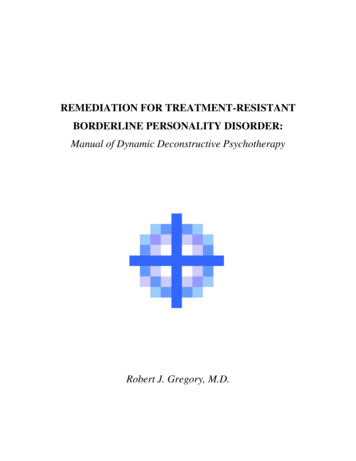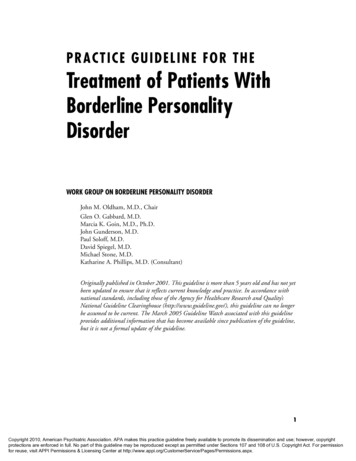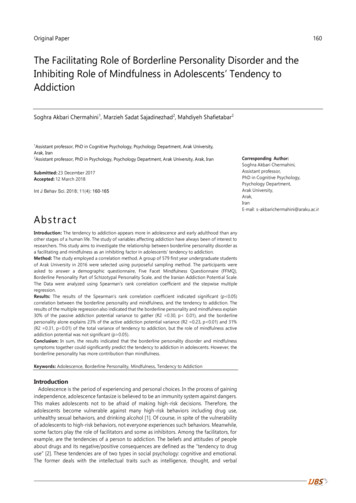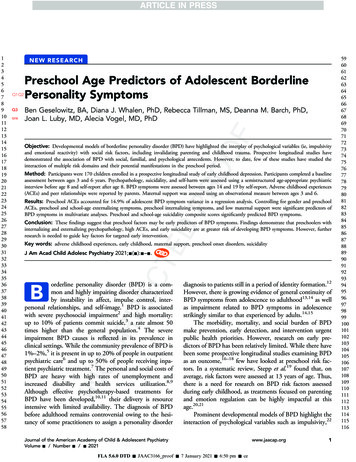
Transcription
REMEDIATION FOR TREATMENT-RESISTANTBORDERLINE PERSONALITY DISORDER:Manual of Dynamic Deconstructive PsychotherapyRobert J. Gregory, M.D.
2DDPClinical, Training, and Research ManualofDynamic Deconstructive Psychotherapy v. 8.29.16Robert J. Gregory, M.D.Professor of PsychiatrySUNY Upstate Medical University750 East Adams StreetSyracuse, NY 13210gregoryr@upstate.edu
3TABLE OF CONTENTSPagesPreface5-61. CONCEPTUALIZATION OF BORDERLINE PD7-162. OVERVIEW OF TREATMENT17-203. ESTABLISHING THE FRAME21-281.2.3.4.5.Gather the historyDetermine eligibility for dynamic deconstructive therapyExplain the therapy and agree on goalsDefine roles, boundaries, and expectationsSupplemental treatments and activities4. STAGES OF THERAPY29-40I. “Can I be safe here?” Establishing the Ideal OtherII. “Do I have a right to be angry?” Debating justification in relational encountersIII. “Am I worthwhile?” Grieving the loss of a fantasy and worries about self-worthIV. “Am I ready to leave?” Overcoming barriers towards self-acceptance5. THE THERAPEUTIC STANCE41-466. STATES OF BEING47-58I.Helpless Victim StateII.Guilty Perpetrator StateIII. Angry Victim StateIV. Demigod Perpetrator StateTreatment Implications7. THE DECONSTRUCTIVE EXPERIENCE59-64
48. SPECIFIC TECHNIQUES65-90I. Associations65II. Attributions70III. Ideal Other73IV. Alterity -- Real Other77V. Managing Self-Destructive and Maladaptive Behaviors839. PSYCHOTROPIC MEDICATIONS91-9210. PSYCHIATRIC COMORBIDITY93-9811. SPECIAL SITUATIONS1.2.3.4.5.99-104Psychiatric hospitalizationSevere dissociationDeterioration in clinical conditionBoundary intrusionsVacations or absences12. MEDICAL CARE105-1081. Somatization2. Medical hospitalization3. Medical complications13. DEVELOPING A DDP PROGRAM109-1101. Training considerations2. Clinical considerationsAPPENDIX A -- DDP Adherence Scale111-114APPENDIX B – Upstate Borderline Questionnaire115-116APPENDIX C – Upstate Borderline Inventory - 9117-118APPENDIX D – Daily Connection Sheet119-120BIBIOGRAPHY121-133
5PREFACEI have written this manual in order to present a training tool for treatment of borderlinepersonality disorder (BPD), especially for those patients who are most challenging to engage in atherapeutic relationship, such as those having substance use disorders or antisocial personality traits. Thepurpose is to delineate an approach that is evidence-based, reliable, time-limited, and relatively easy tolearn. On the other hand, I am well aware of the dangers of oversimplifying human pathos and imposinga reductionistic and rigid treatment model that disregards individual differences. I have thereforeattempted to maintain a balance between clarity and complexity and a broad enough framework toaccommodate different patient needs and individual therapist styles of interaction.In this manual I introduce a new treatment paradigm, labeled dynamic deconstructivepsychotherapy (DDP). The theoretical basis for DDP integrates translational neuroscience with objectrelations theory and Jacques Derrida’s deconstruction philosophy. These three frameworks aresurprisingly compatible with one another, and each contributes a useful perspective on borderlinepathology and treatment. Case vignettes are utilized throughout the manual to illustrate key points. Eachpatient provided consent for use of video recorded material in scientific publications. Nevertheless, eachvignette has undergone careful editing to disguise any identifying information and maintainconfidentiality.The manual incorporates both theory and technique to take the reader step by step through keyconcepts and treatment interventions. The first two chapters summarize the treatment model. The nexttwo chapters, Establishing the Frame and Stages of Therapy, provide a chronological sequence oftreatment, focusing on the major tasks, themes, and interventions that characterize each stage. Thefollowing three chapters, The Therapeutic Stance, States of Being, and The Deconstructive Experience,focus more in depth on the patient-therapist relationship, including how to promote a therapeutic alliance,reflective functioning, and individuation, and how to recognize and disrupt emerging enactments. Thenext two chapters, Specific Techniques and Psychotropic Medications, delineate core DDP interventions,as well as provide a brief summary of principles of medication management. The DDP interventions areorganized by the specific neuroaffective deficit that is being targeted for remediation. Each section alsocontains a list of proscribed interventions. These chapters are followed by a discussion of circumstancesthat sometimes require modification of technique, summarized in three chapters entitled, PsychiatricComorbidity, Special Situations, and Medical Care. The final chapter, Developing a DDP Program,contains guidelines for readers to develop their own training and/or clinical program in DDP and therequirements for achieving certification of competency.There is no theoretical explication in the manual of relative contributions of the genetic anddevelopmental factors that lead to this pathology. This is because the etiology is still under investigationand speculation regarding origin risks creating a false sense of surety about the disorder that couldunfairly label or stigmatize patients and/or family members. There is evidence supporting bothdevelopmental determinants (Battle et al., 2004; Johnson et al., 2006), intergenerational transmission(Weiss et al., 1996), as well as genetic factors (Kendler et al., 2008; Distel et al., 2008; Silverman et al.,1991; Torgersen et al., 2000). But their relative contribution likely varies among different individualswith the disorder.The term deconstructive in labeling the treatment method is not meant to indicate a radicaldeparture from accepted practices or to indicate a destructive process, but rather to describe a confluencebetween deconstruction theory and a specific subset of psychoanalytic theory and technique. To give afew examples, the psychoanalytic emphasis on neutrality that maintains a non-judgmental and nondirective stance, is consistent with the deconstructive emphasis on openness to the other. The concept ofsplitting can be usefully compared to the deconstructive concept of binary oppositions within a text andintolerance of ambiguity. Psychoanalytic concepts of observing ego, empathy, and mentalization can beseen as elements of alterity and the movement from subjectivity to objectivity.Throughout the book, I have endeavored to maintain a multidisciplinary and pantheoreticalorientation. It is likely to be as relevant to psychiatrists as it is to psychologists, clinical social workers,
6and other mental health practitioners. In explaining concepts and methods, I have intentionally attemptedto maintain language that is shared by most mental health disciplines. Nevertheless, I introduce someterms and concepts from the psychoanalytic, philosophical, and neuroscience literatures that I realizemany readers will find challenging to grasp. I did not want to gloss over difficult but relevant conceptsfor the sake of simplicity. I have a deep respect for the complexity, individuality, and endless enigma ofthe human experience. My experience with trainees who have employed the manual is that it can be readon many levels.Some therapists will have more difficulty than others in learning and applying the techniquesoutlined in the manual. The reliance on moment-by-moment inter-subjective experience in DDPpresumes some degree of self-awareness and self-acceptance, toleration of uncertainty and ambiguity, andopenness to change on the part of the therapist (Fishman, 1999). However, after many years of trainingtherapists in these techniques, the most common reason I have observed for therapists’ failure to reliablyimplement the treatment is reluctance to give up sources of gratification inherent in idealized,authoritative therapist roles. It can be very difficult for many therapists to be truly non-judgmental and towithhold providing a profound pronouncement, “validating” statement, interpretation, or sage advice.Empirical research on DDP is substantial and ongoing. This research is summarized on the DDPwebsite: www.upstate.edu/ddp. Approximately 90% of patients who stay in DDP for a full year oftreatment with achieve substantial improvement in symptoms and functioning. Because of strongevidence for effectiveness, the federal agency SAMHSA has included DDP on its list of evidence-basedprograms and practices (www.nrepp.samhsa.gov).Independent ratings of video recorded DDP sessions indicate that adherence to DDP techniques isstrongly correlated with treatment outcome (Goldman & Gregory, 2009; 2010). This finding suggeststhat the treatment works in a specific way to effect change. Because of the importance of treatmentadherence in optimizing outcomes in this challenging patient population, I have included the DDPAdherence Scale, along with instructions for rating, in an appendix to this manual. I recommendemploying the scale for monitoring adherence to DDP in clinical, teaching, and/or research programs thatwish to incorporate this promising treatment approach.
71. CONCEPTUALIZATION OF BORDERLINE PERSONALITY DISORDERBetween the too warm flesh of the literal event and the cold skin of the concept runs meaning (Derrida,1978, p. 75)The term, borderline personality disorder (BPD), derives from an older psychoanalytic term of“borderline personality organization”. A borderline level of personality organization was originallymeant to describe patients who are neither psychotic nor neurotic, but intermediate or on the “borderline”between these two levels of organization (Stern, 1938). Kernberg (1967) elaborated this concept in aseminal paper and defined borderline as having a characteristic triad of identity diffusion, generally intactreality testing, and the use of maladaptive defense mechanisms, especially splitting. Borrowing frompsychoanalytic perspectives of borderline personality organization, Gunderson (1984) helped to establishborderline personality disorder in formal psychiatric nomenclature as a disorder of identity and self.According to the DSM-V (American Psychiatric Association, 2013), “the essential feature of borderlinepersonality disorder is a pervasive pattern of instability of interpersonal relationships, self-image, andaffects” (p. 663). To meet diagnostic criteria for BPD, persons must have at least 5 of the 9 symptomsoutlined in Figure 1-1. These symptoms are highly correlated with one another, supporting the validity ofthe construct of BPD (Clifton, 2007; Johansen, Karterud, Pedersen, Gude, & Falkum, 2004).Although the diagnosis of BPD has been shown to be valid and reliable, the mechanisms andetiology of the disorder are still very controversial. The present chapter lays out a theory postulating thatthe phenomenology of the disorder is accounted for by a combination of an imbedded sense of badnessand specific neuroaffective deficits in processing of emotional experiences.Figure 1-1: DSM-V diagnostic criteria of borderline personality disorder1. Frantic efforts to avoid real or imagined abandonment.2. Unstable and intense interpersonal relationships characterized by alternating betweenextremes of idealization and devaluation.3. Identity disturbance: unstable self-image or sense of self.4. Impulsivity in at least two areas that are potentially self-damaging (e.g. spending, sex,substance misuse, reckless driving, binge eating).5. Recurrent suicidal behavior or threats, or self-mutilating behavior.6. Instability of mood and marked reactivity of mood.7. Chronic feelings of emptiness.8. Inappropriate, intense anger or difficulty controlling anger.9. Transient, stress-related paranoid ideation or severe dissociative symptoms.EMBEDDED BADNESSClinical experience, as well as research findings, suggest that a core difficulty of BPD is a deeplyembedded and often unconscious self-perception of inherent badness, i.e. evil, defective, worthless, lazy,or ugly (Gregory, 2004; Gunderson, 1984; Rüsch et al., 2007). This sense of badness is often notimmediately apparent and difficult to measure in research studies since it can be repressed and denied,even to the point that patients can appear grandiose with an inflated self-appraisal for much of the time.The badness can also be projected onto others, such that BPD patients can become mistrustful, avoidant,or denigrating of others as a way to protect against feelings of shame. The embedded badness can appearin creative activities or in dreams, often as dangerous shadowy figures chasing the patient.
8Causes for embedded badness may be manifold. In his work with traumatized and delinquentchildren, Fairbairn (1943, 1944) noted that they were prone to sacrifice their self-esteem and develop aninner sense of badness in an attempt to maintain an idealized image of an abusive parent. Fairbairnhypothesized that the child splits the image of the abusive parent into both good and bad objects andinternalizes the bad object so as to maintain the fantasy of the parent as the idealized good object. Thusthe child is sacrificing his/her own self-esteem and developing a sense of embedded badness by taking onall the responsibility for the abuse in order to maintain the fantasy of an idealized, safe caregiver.Both trauma and neglect have been associated with the development of BPD in longitudinalstudies (Johnson, Cohen, Chen, Kasen, & Brook, 2006). However, many patients with BPD have nohistory of trauma or neglect, and an embedded sense of inner badness might result from teasing orbullying at school, problematic early mother-infant attachment (Green & Goldwyn, 2002), or inheritedtendencies towards social inhibition, impulsive aggression, or negative affectivity (Conway, Hammen, &Brennan, 2015; Kendler et al., 2008).Regardless of cause, embedded badness can account for much of BPD pathology, such as chronicdysphoria and low self-esteem, bouts of hostility when the badness is projected onto others, episodes ofsevere depression and suicide ideation when the badness is put on oneself, and tendencies towards selfdamaging behaviors, such as cutting or purging. From a social perspective, it may lead to feelings ofembarrassment and anxiety around others, continuous need for reassurance, and trying to put up a falseand compliant front. Imbedded badness and poor self-assertiveness may also account for the tendency ofthis population to get into abusive or maladaptive relationships. A central conflict becomes, “do I have aright to be angry?” or “are my needs legitimate?” (see Chapter 4 on Stages of Therapy).Interventions that attempt to persuade and reassure BPD patients out of their sense of badness aregenerally ineffective, especially in the early stages of treatment. Such efforts tend to come across asunempathic, as though the listener does not understand how very bad the patient really is. Instead, it isfirst necessary to remediate the neuroaffective deficits that interfere with a person’s ability to identify,acknowledge, and accept painful emotions and attributes that have been avoided or split off. Whennegative emotions and painful conflicts can be more fully verbalized and symbolized, it becomes possibleto gradually work towards acceptance of limitations of oneself and others, and to develop more authenticand fulfilling relationships and self-esteem that is grounded in reality.NEUROAFFECTIVE DEFICITSThe neuroaffective deficits of BPD do not involve problems with intelligence, but rather involveproblems with identifying, acknowledging, and bearing painful emotions and conflicts. In order to have acoherent, stable, and differentiated self, it is necessary to have three essential neuroaffective capacities.These include the ability to identify and verbally acknowledge one’s emotional experiences, to integratecomplex attributions of these experiences, and to be able to assess the accuracy of those attributions in anobjective way. Gregory and Remen (2008) have labeled these three neuroaffective functions asassociation, attribution, and alterity.1. AssociationFigure 1-2 is a simplified diagrammatic display of adaptive processing of emotional experiences.The first step needed for adaptive processing is to encode our experiences into language, metaphor, andother symbols, so that they can be acknowledged and communicated (Bucci, 2002). We react to aprovocative interpersonal encounter with an affective response, which we experience in our bodies. Wethen try to make sense of this experience by creating a verbal/symbolic description. We also need to beable to sequence the experience, i.e. to connect our response to the initial provocation. As we begin tomake these links, we can make reasonable attributions about ourselves and others, while relying on ourmemory of similar encounters, and finally come to a decision as to how best to respond. For example,when someone makes a demeaning comment, most people will respond by creating an internal dialogue,
9acknowledging to themselves how that person is making them feel. They may then perhaps questionwhether the demeaning comment is accurate or whether the person was making an unjustified attack andrespond accordingly.Figure 1-2: Adaptive emotion processing of experienceactionattributions ofself and otherinterpersonalstimuluslabel emotions &sequence experienceFigure 1-3: Emotion processing in borderline personality alenactment1. Impulsive behaviors2. Symbolic objects3. Idealized el emotions &sequence experience
10The labeling and sequencing of one’s emotional experiences I am calling association functions.This capacity helps connect us to our experiences. It also allows a reflective space between theexperiencing and observing parts of the self so that we are able to comment on our experiences in aninternal dialogue and communicate them with others. The ability to observe, label, and comment onone’s experiences is an essential component of consciousness and a subjective sense of self.As Figure 1-3 schematically displays, a key hypothesized functional deficit of BPD is the abilityto label and sequence emotional experiences. Persons with BPD often have a rich ability to employabstract metaphors and visual symbols through poetry and art, but have much difficulty consciouslylinking language and other abstract symbols to their experiences. They often have difficulty interpretingtheir poetry or art, pinpointing a particular emotion, or even acknowledging words that they justemployed. A study by Levine, Marziali, and Hood (1997) of 30 subjects with BPD compared to 40healthy controls indicated that the subjects with BPD had difficulty identifying their own emotions,differentiating between emotions and correctly identifying facial expressions of emotions. In a study of252 consecutive individuals seeking treatment at a mental health clinic, BPD was associated with greaterimpairment in identifying and describing emotions than any other psychiatric diagnosis (Zlotnick, Mattia,& Zimmerman, 2001). Employing 24-hour ambulatory monitoring of psychological reactions andphysiological parameters of 50 patients with BPD and 50 healthy controls, Ebner-Priemer and colleagues(2007) reported that prior to entering treatment, patients with BPD have greater difficulty identifying andlabeling their emotions than healthy controls. The inability to identify, acknowledge, and verbalizeexperiences contributes to feelings of emptiness and lack of a subjective sense of self.Many individuals with BPD also have deficits in episodic or autobiographical memory, i.e. alimited ability to coherently narrate a specific emotionally-charged interpersonal encounter and putevents, emotions, and actions into a clear sequence. For example, they may complain of depression oranxiety that comes “out of the blue” and not be able to identify the specific event that triggered theirchange in mood. Alternatively, some individuals may produce over-general memories and describegeneral patterns of interaction instead of specific incidents. For example, they may glibly verbalize alitany of complaints about how a given person has mistreated them, but may stutter and stammer whentrying to piece together a specific encounter with that person. The tendency to produce over-generalmemories has been linked to depression, dissociation, post-traumatic stress disorder, eating disorders, andsuicide attempts (Arntz, Meeren, & Wessel, 2002; Heard, Startup, Swales, Williams, & Jones, 1999;Williams et al., 2007).Episodic memory deficits are most often seen when BPD is accompanied by dissociativesymptoms (Fonagy et al., 1996) or by an incoherent/disorganized attachment style on the adultattachment interview (Levy et al., 2006; Westen, Nakash, Cannon, & Bradley, 2006). They may havemore marked association deficits, including disorganization, confusion, memory lapses, and incoherenceof narratives, when describing emotionally evocative events. For example, narrative accounts ofinterpersonal interactions may suddenly and repeatedly switch contexts to different persons, places, ortimes. The listener ends up feeling very confused, as well as often bored and detached. Clinicalexperience suggests that the disorganized subgroup of patients need considerable work early in thetreatment on helping them to make basic narrative connections.One perspective on association deficits, is that they serve a defensive function to exclude certainaspects of experience from consciousness that are simply too frightening or painful (Wildgoose, Waller,Clarke, & Reid, 2000). Although retrospective studies have linked dissociation to childhood trauma, twolongitudinal prospective studies have both indicated the importance of early mother-infant attachment,rather than physical or sexual abuse. Taken together, these studies indicate that maternalunresponsiveness to infant fear or distress strongly predict the development of dissociative symptoms inadulthood, regardless of the infant’s attachment style or subsequent abuse (Dutra, Bureau, Holmes,Lyubchik, & Lyons-Ruth, 2009; Ogawa, Sroufe, Wcinfield, Carlson, & Egeland, 1997). Maternalinattention to her infant’s negative affect may prevent the infant from acquiring the ability to contain and
11symbolize distressing experiences, which then remain cut off from consciousness and poorly integratedinto the self-structure.2. AttributionIn addition to association functions, a second neuroaffective component of our emotionprocessing involves attributing meaning to those experiences. From our experiences we learn about ourstrengths and limitations, and those of others. We learn what responses and behaviors to expect fromourselves in diverse situations, and what kind of responses to expect from others. We make attributionsregarding responsibility, praise, and blame, portioning out agency to self or others according to thesituation. Our attributions of value, motivation, and agency are extremely complex and sometimespainful to acknowledge. For example, it is painful to acknowledge that the person we are in love withmay not love us back. It is painful to acknowledge that we are mostly to blame for certain unpleasantcircumstances in our lives.This capacity to formulate realistic and complex attributions of oneself and others is deficient inpersons with BPD. Instead, they tend to form simplistic, distorted, and polarized attributions of theirexperiences (Coifman, Berenson, Rafaeli, & Downey, 2012). Thus the person with BPD lives in a blackand white fantasy world, full of cardboard cut-out villains and heroes. Polarization of self and other intoall-good and all-bad has been labeled splitting in the psychoanalytic literature (Kernberg, 1975).Polarized attributions may serve to help limit the pain and dysfunction of embedded badness.One strategy for coping with embedded badness is to repress negative aspects of the self fromconsciousness and project those onto others. Employing this strategy, self-image is transformed into anall-good idealized self-image, innocent of any wrong-doing, whereas others are perceived as troublemakers. However, this coping strategy is unstable, and persons with BPD often alternate between a selfimage that is either all-good or all-bad. The oscillation in self-image contributes to an identitydisturbance, to an unstable relatedness pattern of idealization and devaluation, and to symptoms of moodlability (Koenigsberg et al., 2001). When the self is perceived as all-bad, then mood becomes depressed,but relatedness is maintained with an all-good other. When the badness is projected onto others, thenmood becomes angry or elated, but relatedness is compromised (see chapter on States of Being).Another function of a polarized attribution system is to maintain a sense of certainty. Research inexperimental psychology suggests that uncertainty drives our tendencies to make attributions of causality(Burger & Hemans, 1988; Pittman & Pittman, 1980; Weiner, 1985). Because of their inability to identifyand verbalize their emotional experiences, persons with BPD are essentially emotionally “blind” and livein an uncertain world. Neuroscience research suggests that during an interpersonal encounter, the kind ofattributions we make regarding self and others are closely linked to the specific emotions that weexperience (Olsson & Ochsner, 2007). In the absence of an emotion anchor, polarized attributions putthings into black and white, eliminate ambiguity and create an artificial sense of certainty.Persons with BPD have been noted to have a need for certainty and for complete understandingfrom others (Bateman, 1996; Shapiro, 1992). They employ a binary system of logic and attribution thatexcludes alternative perspectives that may create ambiguity. For example, they may tell their therapists,“If you really cared about me, then you would let me call more often. All you care about is your money.”On the surface, the proposition appears logical and irrefutable. However, there is an underlyingassumption that the therapist’s primary mission should be to care and nurture their patients like a mother.There is also an implied dichotomy or split in the perspective of the therapist as either totally caring andaccommodative, or totally cold and callous. There is no room in such a polarized attribution system for amore ambiguous and realistic perspective of the therapist as having complex motivations, including somegenuine caring for the patient, but within certain limits.3. AlterityAlthough the ability to describe experiences and attribute meaning to them is necessary for acoherent sense of self, an additional neuroaffective capacity is needed in order to develop a differentiatedself. Alterity is a word borrowed from the philosophical literature meaning a reference point outside the
12subjectivity of the self, what Derrida described as an absolute outside (Derrida, 1978, p. 106). This isanalogous to a ship’s need for an outside reference point, such as a lighthouse, star system, or satellite, inorder to know its position. Alterity enables us to reflect on ourselves from an outside or “objective”perspective, i.e. “How realistic are my attributions?”When the capacity for alterity is diminished, individuals live in a magical world, wheresubjectivity is ungrounded in reality. In this magical world, behaviors such as cutting, purging,restricting, and substance use can take on special significance and be used for coping (Gregory &Mustata, 2012). For example, a person with an alterity deficit can cut his/her arm and believe that theblood pouring out of the body is “the badness flowing out of me.” In this instance, the blood symbolizesthe self’s inner badness and to find relief from the sense of badness through cutting. Likewise alcoholand other drugs can magically substitute for interpersonal relationships (“my best friend is the bottle”)and thus help meet attachment needs (see chapter on Psychiatric Comorbidity for further discussion).Another consequence of a diminished capacity for alterity is an inability to objectively assess theaccuracy and realistic consequences of our attributions and motivations, and those of others. A realisticappreciation of the attributions and motivations of other persons has been called mentalization (Fonagy &Target, 1996) derived from theory of mind (Premack & Woodruff, 1978). For persons with BPD, thedeficit in alterity contributes to their ability to maintain very distorted and polarized attributions in theface of contradictory evidence. For example, persons with BPD have been shown to misread others’intentions in an economic game of trust, thus leading to poor overall performance (King-Casas et al.,2008).A third consequence of a deficit in alterity is a lack of a clear boundary between self and otherthat includes an inability to differentiate between one’s own wishes, emotions, and attributions and thoseof others. The capacity to be oneself in relationships I am labeling as differentiated relatedness. Everypatient with BPD I have met thus far is lacking in this capacity. They adopt the values and opinions ofthe other person in order to maintain relatedness, much like a chameleon. Alternatively, in order tomaintain a stable sense of self and others, they may distance themselves in a paranoid or narcissisticmanner. For example, persons with BPD may assume that others are looking at them in a derogatoryway, when in fact it is they themselves who are feeling ashamed. Similar to attribution deficits, deficits inalterity may be driven in part by a need for certainty. In psychology research, high levels of uncertaintycan result in a tendency to stereotype others (Neuberg & Newsom, 1993), in illusory pattern perceptions,and in perception of conspiracies (Whitson & Galinsky, 2008).In philosophical terms, the person with BPD can be viewed as having unchallenged an
borderline personality disorder in formal psychiatric nomenclature as a disorder of identity and self. According to the DSM-V (American Psychiatric Association, 2013), "the essential feature of borderline personality disorder is a pervasive pattern of instability of interpersonal relationships, self-image, and affects" (p. 663).










